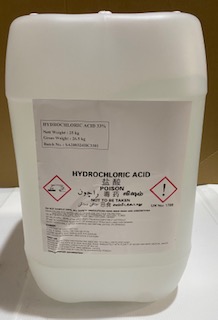Description
Hydrochloric Acid (HCl) is a strong, corrosive acid used widely in industrial and laboratory environments. It’s a colourless solution made by dissolving hydrogen chloride gas in water.
Known for its ability to dissolve metals and form chloride salts, HCl is highly acidic. It releases hydrogen chloride gas, particularly when heated. Industrially, it is produced through the chlorination of organic chemicals or by synthesising hydrogen and chlorine gases, which are then absorbed in water.
Our Hydrofluoric Acid is precisely formulated to deliver optimal performance for a broad range of applications. It’s available in various concentrations to meet specific needs and comes in specialised, HF-resistant packaging to ensure safe handling and storage.
We emphasise safety with our Hydrofluoric Acid, providing detailed guidelines for its use. We highly recommend using proper personal protective equipment (PPE) and following safety protocols to prevent exposure and protect workplace safety.





